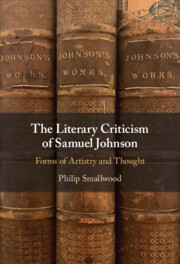10 results
Chapter 1 - The 300th Anniversary Bookend Prime Ministers
-
- Book:
- The Impossible Office?
- Published online:
- 14 March 2024
- Print publication:
- 14 March 2024, pp 1-29
-
- Chapter
-
- You have access
- HTML
- Export citation
3 - Vietnam and Rolling Thunder: 1965–1966
-
- Book:
- Tactical Air Power and the Vietnam War
- Published online:
- 04 January 2024
- Print publication:
- 18 January 2024, pp 35-76
-
- Chapter
- Export citation
Introduction
-
- Book:
- The Literary Criticism of Samuel Johnson
- Published online:
- 07 September 2023
- Print publication:
- 21 September 2023, pp 1-14
-
- Chapter
- Export citation

The Literary Criticism of Samuel Johnson
- Forms of Artistry and Thought
-
- Published online:
- 07 September 2023
- Print publication:
- 21 September 2023
Chapter 17 - Johnson among the Scholars
-
-
- Book:
- The New Cambridge Companion to Samuel Johnson
- Published online:
- 22 September 2022
- Print publication:
- 29 September 2022, pp 239-251
-
- Chapter
- Export citation
Chapter 6 - The New Gilded Age and Mass Incarceration
- from Part II - The Twentieth Century
-
- Book:
- Never Together
- Published online:
- 10 February 2022
- Print publication:
- 24 February 2022, pp 183-210
-
- Chapter
- Export citation
5 - Conflict Dynamics across Space and Time: Public Opinion in the Korean and Vietnam Wars
-
- Book:
- Costly Calculations
- Published online:
- 18 June 2021
- Print publication:
- 08 July 2021, pp 128-159
-
- Chapter
- Export citation
7 - Literary and Aesthetic Theory
-
-
- Book:
- The Cambridge Companion to Eighteenth-Century Thought
- Published online:
- 15 June 2021
- Print publication:
- 20 May 2021, pp 205-226
-
- Chapter
- Export citation
Chapter 12 - Samuel Johnson and the ‘First English Dictionary’
- from Eighteenth-Century English Dictionaries: Prescriptivism and Completeness
-
-
- Book:
- The Cambridge Companion to English Dictionaries
- Published online:
- 18 September 2020
- Print publication:
- 24 September 2020, pp 142-154
-
- Chapter
- Export citation
Chapter 11 - Recording the Most Proper and Significant Words
- from Eighteenth-Century English Dictionaries: Prescriptivism and Completeness
-
-
- Book:
- The Cambridge Companion to English Dictionaries
- Published online:
- 18 September 2020
- Print publication:
- 24 September 2020, pp 129-141
-
- Chapter
- Export citation



